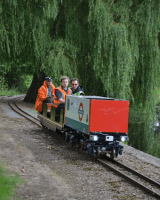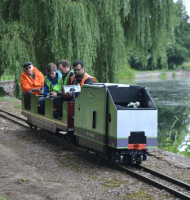That’s exactly what four university teams are doing as they ready themselves for this summer’s Institution of Mechanical Engineers’ Railway Challenge in Leicestershire.
Teams from the Universities of Birmingham, Huddersfield University (who won in 2013), Sheffield, and Southampton are going up against competitors from Interfleet Technology Ltd (winners in 2012), TE Connectivity, Transport for London (last year’s winners) and Warwick Manufacturing Group.
According to IMEchE, the competition comprises of two presentation challenges, one of which is the submission of a design report and the other being a business case presentation, and six track based challenges that will be decided over the weekend. These include: energy storage, traction, ride comfort, noise and, new for the 2015 competition, maintainability and energy efficiency.

Prof Simon Iwnicki, chair of the Railway Challenge took some time out to talk to the Student Engineer about what the competition entails, how competitors should prepare and how taking part will look great on your CV.
Can competitors draw on any advice to guide them through the Challenge?
The teams must make all design decisions themselves. They can take advice from academic experts or practicing engineers and the Railway Challenge Committee offers to assist teams in making contact with appropriate senior colleagues. In this way the location of a team (in a University or in industry) should not make a big difference. In the three years of the competition so far it has been won by a university once and by teams from industry twice.
What are the judges looking for in the presentation challenges and how should entrants prepare?
The aim of these challenges is to allow students to experience real life business scenarios.
For the presentation (the Business case challenge) we ask teams to imagine that they are representatives of a design consultancy making a sales pitch to the executives of a large corporation interested in buying a number of their locomotives. The most successful teams have been able to give the ‘executives’ or judges confidence that their design will be safe, efficient, cost effective and reliable. The teams have to demonstrate that they have not only thought about the engineering solutions but demonstrate good marketing and commercial acumen.
In the design report (the Design Challenge) reports are marked on a range of aspects including appropriate use of innovation, design for maintainability, costing et cetera. A key skill is in getting a lot of information across in a clear and concise manner; the main section of the report is limited to 10 pages.
Competitors need to demonstrate that they have a full understanding of what is being asked of them in the rules and technical specification document. They are marked on how well they prove their compliance to the necessary requirements detailed in the competition documentation whether this be through examples of design, analysis or testing.
By the same rationale, what criteria will the judges use to assess the six track based challenges, and in what ways can entrants give themselves an advantage?
The track based challenges require students to design and build a locomotive that is energy efficient and quiet, which provides good traction and a comfortable ride. It must deliver an energy storage solution (a real life problem for any locomotive manufacturer) and be maintainable. These challenges are very clearly defined in the rules and further clarity is provided by the Railway Challenge Committee thorough published questions and answers.
The main problems in the past have resulted from lack of testing. Although this is natural for teams of inexperienced young engineers who all have other priorities during the year, it has been clear that those teams who have managed to complete a vehicle well in advance of the competition and have been able to carry out trials before the final have certainly reduced the number of unexpected problems occurring on the day.
What key traits should individuals in each team bring to the competition?
Enthusiasm (and that is evident in bucketloads!), tenacity (same) and a willingness to ask for help (less so!) Above all of this teamwork is the key requirement for the Railway Challenge as it is with most engineering projects. Teams that pull together win together.

What skills will students gain from taking part in the Railway Challenge and will it look good on their CVs?
The Railway Challenge gives competitors a hands-on experience of everything that is involved in developing a locomotive, from initial planning and developing a business case, through to actually making and testing the finished product.
Some of the key skills which employers always ask for - such as communication, team working and a ‘practical feel for what will work and what won’t’ - cannot be taught.
The Railway Challenge provides a perfect environment for these skills to be developed. Several of the university team members have taken jobs in the railway industry following their participation in the competition.
[Ultimately] this competition gives competitors a real life experience of an interdisciplinary project – today’s engineers rarely just work within one discipline such as mechanical engineering but need to make sure that what is designed can be integrated to interface with electronic and software systems to create an end solution.
The Railway Challenge will be taking place at Stapleford Miniature Railway near Melton Mowbray in Leicestershire on 26 to 28 June 2015




Project to investigate hybrid approach to titanium manufacturing
What is this a hybrid of? Superplastic forming tends to be performed slowly as otherwise the behaviour is the hot creep that typifies hot...